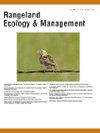Awareness and Social Interactions Influence Natural Resource Professionals’ Recommendations for Prescribed Fire Use
IF 2.4
3区 环境科学与生态学
Q2 ECOLOGY
引用次数: 0
Abstract
Restoring fire in fire-adapted ecosystems is necessary to curtail woody plant expansion, enhance biodiversity, and reduce wildfire risks, yet prescribed fire is promoted less by federal agencies than other grassland conservation practices. The U.S. Department of Agriculture Natural Resources Conservation Service (NRCS) is the primary federal agency responsible for the delivery of rangeland conservation incentives to private landowners in the Great Plains. The degree to which NRCS employees choose to offer technical guidance on prescribed fire and whether they encourage landowners to consider financial support is not well-understood and varies among states. Our study explored the extent to which prescribed fire awareness and social interaction factors influence NRCS employees' knowledge and comfort level regarding prescribed fire and the frequency with which they recommend this conservation practice. The results show that while prescribed fire awareness influences knowledge, it was not significantly associated with frequency of prescribed fire recommendations. Rather, social interaction factors were significantly related to recommendation frequency; these included priority of prescribed fire education in their jobs, positive interactions with landowners regarding prescribed fire, and how often they were asked to deal with brush management. An important implication is that while better knowledge about prescribed fire is necessary, it is not sufficient for more frequent prescribed fire recommendation by natural resource professionals. Instead of focusing primarily on technical proficiency, federal agencies tasked with expanding the application of prescribed fire as an ecosystem restoration and wildfire mitigation tool should focus more on building stronger social networks through, for example, providing greater support of existing and new prescribed burning associations. Our findings also have implications for a national unified policy that supports the application of prescribed fire on privately-owned rangelands because negative fire culture at the federal level has an erosive effect on agencies’ willingness to assist landowners with prescribed fire applications.
意识和社会互动影响自然资源专业人员对规定火灾使用的建议
在适应火灾的生态系统中恢复火灾对于减少木本植物的扩张、增强生物多样性和降低野火风险是必要的,但联邦机构提倡的规定火灾比其他草原保护措施要少。美国农业部自然资源保护局(NRCS)是负责向大平原地区的私人土地所有者提供牧场保护奖励的主要联邦机构。NRCS的雇员在多大程度上选择对规定的火灾提供技术指导,以及他们是否鼓励土地所有者考虑财政支持,这些都没有得到很好的理解,各州之间也各不相同。我们的研究探讨了规定火灾意识和社会互动因素对NRCS员工关于规定火灾的知识和舒适度的影响程度,以及他们推荐这种保护实践的频率。结果表明,虽然规定的火灾意识影响知识,但它与规定的火灾建议的频率不显着相关。相反,社会互动因素与推荐频率显著相关;其中包括在他们的工作中优先进行规定火灾教育,与土地所有者就规定火灾进行积极互动,以及他们被要求处理灌木丛管理的频率。一个重要的含义是,虽然更好地了解规定的火灾是必要的,但这不足以让自然资源专业人员更频繁地推荐规定的火灾。与其把重点放在技术熟练程度上,负责扩大规定火灾作为生态系统恢复和野火缓解工具的应用的联邦机构应该更多地关注建立更强大的社会网络,例如,通过为现有和新的规定火灾协会提供更大的支持。我们的研究结果还对支持在私有牧场上应用规定火灾的国家统一政策具有启示意义,因为联邦一级的负面火灾文化对各机构协助土地所有者申请规定火灾的意愿具有侵蚀性影响。
本文章由计算机程序翻译,如有差异,请以英文原文为准。
求助全文
约1分钟内获得全文
求助全文
来源期刊

Rangeland Ecology & Management
农林科学-环境科学
CiteScore
4.60
自引率
13.00%
发文量
87
审稿时长
12-24 weeks
期刊介绍:
Rangeland Ecology & Management publishes all topics-including ecology, management, socioeconomic and policy-pertaining to global rangelands. The journal''s mission is to inform academics, ecosystem managers and policy makers of science-based information to promote sound rangeland stewardship. Author submissions are published in five manuscript categories: original research papers, high-profile forum topics, concept syntheses, as well as research and technical notes.
Rangelands represent approximately 50% of the Earth''s land area and provision multiple ecosystem services for large human populations. This expansive and diverse land area functions as coupled human-ecological systems. Knowledge of both social and biophysical system components and their interactions represent the foundation for informed rangeland stewardship. Rangeland Ecology & Management uniquely integrates information from multiple system components to address current and pending challenges confronting global rangelands.
 求助内容:
求助内容: 应助结果提醒方式:
应助结果提醒方式:


